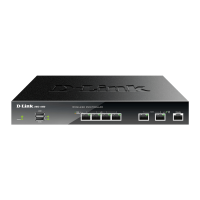D-Link DWC-1000 User Manual 116
Section 4 - Advanced WLAN Conguration
Field Description
cwMan (Maximum
Contention Window)
The value specied here in the Maximum Contention Window is the upper limit (in
milliseconds) for the doubling of the random backo value. This doubling continues until
either the data frame is sent or the Maximum Contention Window size is reached.
Once the Maximum Contention Window size is reached, retries will continue until a
maximum number of retries allowed is reached.
Valid values for the cwmax are 1, 3, 7, 15, 31, 63, 127, 255, 511, or 1024. The value for
cwmax must be higher than the value for cwmin.
Max. Burst
AP EDCA Parameter Only (The Max. Burst Length applies only to trac owing from the
access point to the client station.) This value species (in milliseconds) the Maximum Burst
Length allowed for packet bursts on the wireless network. A packet burst is a collection
of multiple frames transmitted without header information. The decreased overhead
results in higher throughput and better performance. Valid values for maximum burst
length are 0 through 999.
General Parameters
WMM Mode
Wi‐Fi MultiMedia (WMM) is enabled by default. With WMM enabled, QoS prioritization
and coordination of wireless medium access is on. With WMM enabled, QoS settings on
the D‐Link controller control downstream trac owing from the access point to client
station (AP EDCA parameters) and the upstream trac owing from the station to the
access point (station EDCA parameters).
Disabling WMM deactivates QoS control of station EDCA parameters on upstream trac
owing from the station to the access point. With WMM disabled, you can still set some
parameters on the downstream trac owing from the access point to the client station
(AP EDCA parameters).
To disable WMM extensions, switch OFF.
To enable WMM extensions, switch ON.
Station EDCA Parameters
Queue
Queues are dened for dierent types of data transmitted from station‐to‐AP:
• Data 0 (Voice)—Highest priority queue, minimum delay. Time‐sensitive data such as
VoIP and streaming media are automatically sent to this queue.
• Data 1(Video)—Highest priority queue, minimum delay. Time‐sensitive video data is
automatically sent to this queue.
• Data 2 (best eort)—Medium priority queue, medium throughput and delay. Most
traditional IP data is sent to this queue.
• Data 3 (Background)—Lowest priority queue, high throughput. Bulk data that
requires maximum throughput and is not time‐sensitive is sent to this queue (FTP
data, for example).
AIDS (Inter-Frame Space)
The Arbitration Inter‐Frame Spacing (AIFS) species a wait time for data frames. The wait
time is measured in slots. Valid values for AIFS are 1 through 255.
cwMin (Minimum
Contention Window)
This parameter is used by the algorithm that determines the initial random backo wait
time (window) for data transmission during a period of contention.
The value specied in the Minimum Contention Window is the upper limit (in milliseconds)
of a range from which the initial random backo wait time is determined.
The rst random number generated will be a number between 0 and the number
specied here.
If the rst random backo wait time expires before the data frame is sent, a retry counter is
incremented and the random backo value (window) is doubled. Doubling will continue
until the size of the random backo value reaches the number dened in the Maximum
Contention Window.

